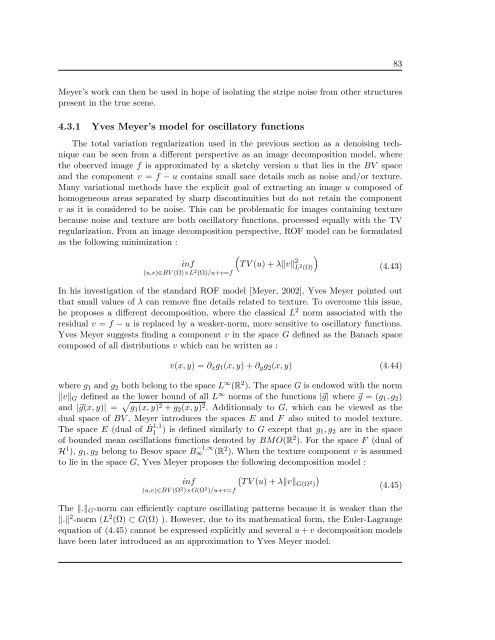Th`ese Marouan BOUALI - Sites personnels de TELECOM ParisTech
Th`ese Marouan BOUALI - Sites personnels de TELECOM ParisTech
Th`ese Marouan BOUALI - Sites personnels de TELECOM ParisTech
You also want an ePaper? Increase the reach of your titles
YUMPU automatically turns print PDFs into web optimized ePapers that Google loves.
83<br />
Meyer’s work can then be used in hope of isolating the stripe noise from other structures<br />
present in the true scene.<br />
4.3.1 Yves Meyer’s mo<strong>de</strong>l for oscillatory functions<br />
The total variation regularization used in the previous section as a <strong>de</strong>noising technique<br />
can be seen from a different perspective as an image <strong>de</strong>composition mo<strong>de</strong>l, where<br />
the observed image f is approximated by a sketchy version u that lies in the BV space<br />
and the component v = f − u contains small sace <strong>de</strong>tails such as noise and/or texture.<br />
Many variational methods have the explicit goal of extracting an image u composed of<br />
homogeneous areas separated by sharp discontinuities but do not retain the component<br />
v as it is consi<strong>de</strong>red to be noise. This can be problematic for images containing texture<br />
because noise and texture are both oscillatory functions, processed equally with the TV<br />
regularization. From an image <strong>de</strong>composition perspective, ROF mo<strong>de</strong>l can be formulated<br />
as the following minimization :<br />
inf<br />
(u,v)∈BV (Ω)×L 2 (Ω)/u+v=f<br />
(<br />
)<br />
TV(u)+λ‖v‖ 2 L 2 (Ω)<br />
(4.43)<br />
In his investigation of the standard ROF mo<strong>de</strong>l [Meyer, 2002], Yves Meyer pointed out<br />
that small values of λ can remove fine <strong>de</strong>tails related to texture. To overcome this issue,<br />
he proposes a different <strong>de</strong>composition, where the classical L 2 norm associated with the<br />
residual v = f − u is replaced by a weaker-norm, more sensitive to oscillatory functions.<br />
Yves Meyer suggests finding a component v in the space G <strong>de</strong>fined as the Banach space<br />
composed of all distributions v which can be written as :<br />
v(x, y) =∂ x g 1 (x, y)+∂ y g 2 (x, y) (4.44)<br />
where g 1 and g 2 both belong to the space L ∞ (R 2 ). The space G is endowed with the norm<br />
‖v‖ G <strong>de</strong>fined as the lower bound of all L ∞ norms of the functions |⃗g| where ⃗g =(g 1 ,g 2 )<br />
and |⃗g(x, y)| = √ g 1 (x, y) 2 + g 2 (x, y) 2 . Additionnaly to G, which can be viewed as the<br />
dual space of BV , Meyer introduces the spaces E and F also suited to mo<strong>de</strong>l texture.<br />
The space E (dual of Ḃ 1,1<br />
1 ) is <strong>de</strong>fined similarly to G except that g 1,g 2 are in the space<br />
of boun<strong>de</strong>d mean oscillations functions <strong>de</strong>noted by BMO(R 2 ). For the space F (dual of<br />
H 1 ), g 1 ,g 2 belong to Besov space B∞<br />
−1,∞ (R 2 ). When the texture component v is assumed<br />
to lie in the space G, Yves Meyer proposes the following <strong>de</strong>composition mo<strong>de</strong>l :<br />
(<br />
TV(u)+λ‖v‖G(Ω ))<br />
2 (4.45)<br />
inf<br />
(u,v)∈BV (Ω 2 )×G(Ω 2 )/u+v=f<br />
The ‖.‖ G -norm can efficiently capture oscillating patterns because it is weaker than the<br />
‖.‖ 2 -norm (L 2 (Ω) ⊂ G(Ω) ). However, due to its mathematical form, the Euler-Lagrange<br />
equation of (4.45) cannot be expressed explicitly and several u + v <strong>de</strong>composition mo<strong>de</strong>ls<br />
have been later introduced as an approximation to Yves Meyer mo<strong>de</strong>l.















